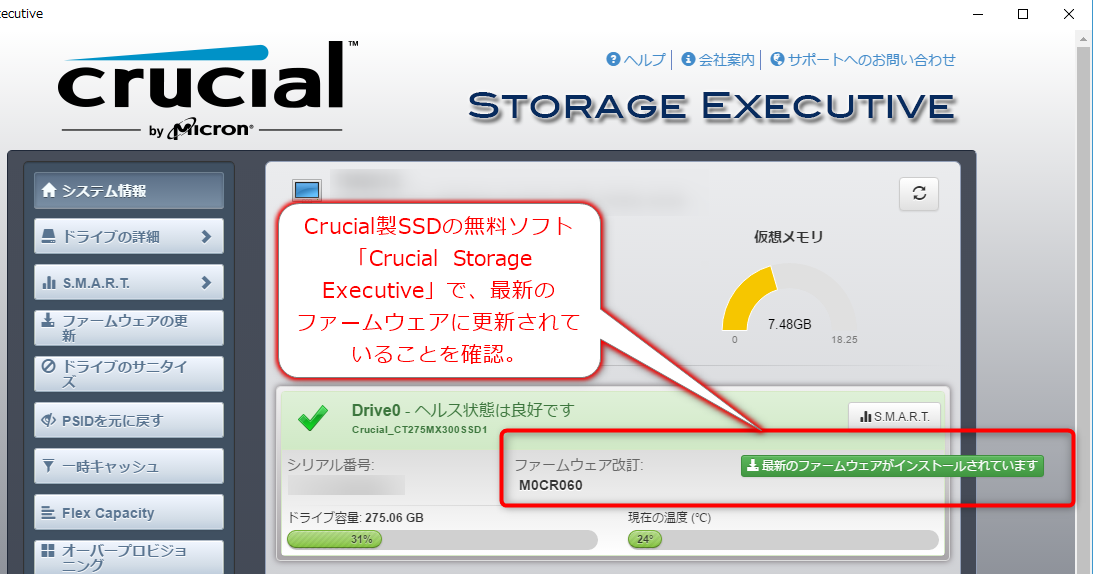

- CRUCIAL STORAGE EXECUTIVE DOESNT RECOGNIZE SSD DO TO RAID INSTALL
- CRUCIAL STORAGE EXECUTIVE DOESNT RECOGNIZE SSD DO TO RAID UPDATE
- CRUCIAL STORAGE EXECUTIVE DOESNT RECOGNIZE SSD DO TO RAID DRIVER
- CRUCIAL STORAGE EXECUTIVE DOESNT RECOGNIZE SSD DO TO RAID SOFTWARE
- CRUCIAL STORAGE EXECUTIVE DOESNT RECOGNIZE SSD DO TO RAID WINDOWS
After following the manufacturer’s instructions on updating the Chipset driver, restart the computer and then launch the Storage Executive software.
CRUCIAL STORAGE EXECUTIVE DOESNT RECOGNIZE SSD DO TO RAID DRIVER
This will cause the system to restart in AHCI mode and, pending the OS changes you performed are correct, the system will boot like normal.Īfter the system is booted in AHCI, the next step would be updating the Chipset driver to its latest revision listed for your computer by the system/motherboard manufacturer on their support site. After changing the necessary settings in the OS, reboot into the BIOS and change the SATA mode to AHCI, then exit saving changes.
CRUCIAL STORAGE EXECUTIVE DOESNT RECOGNIZE SSD DO TO RAID WINDOWS
Since the changes differ depending on each Windows version, be sure to follow the instructions for your specific OS type. To find these instructions, simply search “Change from RAID to AHCI” for your Windows© version. Once you have all the important data backed up, you will need to follow instructions for modifying your systems Operating Systems (OS) prior to changing the BIOS.
CRUCIAL STORAGE EXECUTIVE DOESNT RECOGNIZE SSD DO TO RAID INSTALL
If you feel comfortable in your technical abilities (and are not afraid to perform a fresh install if something goes wrong), we recommend backing up any important data first in case there is a problem. We recommend this for only those with strong technical knowledge or professionals due to the risk of systems failing to boot if performed incorrectly. These changes may be difficult for the average computer user. Before making any change in your BIOS, you will need to boot into your computer like normal and adjust the operating system. However, changing this mode is a bit more complex than just selecting AHCI and saving the changes, which results in a blue screen crash. The recommended setting for a Crucial SSD is AHCI, and having it set as IDE or RAID can cause detection issues in our Storage Executive software. The mode settings are IDE, RAID, or AHCI (Advanced Host Controller Interface). The SATA Mode setting can be in a few different locations depending on the system manufacturer and BIOS or UEFI revision, so you may have to look around to find it. To check this setting, you will need to boot into your system firmware interface, depending on your system either UEFI (Unified Extensible Firmware Interface) or BIOS (Basic Input Output System). The SATA Operation Mode (or SATA Mode) is how the system communicates with the installed drive. The information below will walk you through the most common way to resolve the issue. This occurs either from an outdated or incompatible Chipset/SATA (Serial Advanced Technology Attachment) driver, or when the SATA mode is set to either IDE (Integrated Drive Electronics) or RAID (Redundant Array of Independent Disks). Even when it will detect other non-Crucial drives in your system.
CRUCIAL STORAGE EXECUTIVE DOESNT RECOGNIZE SSD DO TO RAID SOFTWARE
None of these firmware versions is upgradeable to or from the other because of different controllers and/or RAM.There are some instances when Crucial’s Storage Executive software will not detect a Crucial SSD. I had no idea they had so many firmware versions for what is being sold under the same part number (I observed 3 firmware versions in a sample of 6 SU800-256 SSDs: R0247ANR, Q0922FS and R0247AC). If I had to build this RAID array again, I wouldn't have chosen ADATA. ADATA says that running these two firmware versions in RAID is fine. I'm currently running four SU800-256 (Firmware R0427ANR) in RAID10 and keeping an additional SU800-256 (Firmware R0427AC) as a "hot" spare.

CrystalDiskInfo is able to report SMART data for the individual drives even when they're in the RAID array, so diagnosing a failed drive is easy. These SU800s are TLC, so we're sacrificing reliability for cost. Replacement of the SSD was as simple as replacing the failed drive with the new drive and the RAID Array automatically rebuilt the replacement SSD. Fortunately, the RAID Array never skipped a beat and the system continued to operate without issues (despite the failing and eventually failed SSD).įor anyone who needs a reasonably high degree of reliability with the ADATA SU800-256 in a desktop or server, I would strongly recommend RAID. The new SU800 is error-free (so far) and RAID controller errors are back to 0. My Intel RAID controller did eventually mark this failing SSD as "Failed" (after less than 30 days of ownership) before I replaced it. I replaced the SU800 that was reporting an increasing number of "Reallocated Sectors Count" and "Reallocation Event Count" SMART errors. Knowing what I know now, I would not purchase ADATA SU800-256 SSDs for a RAID array (too many firmware versions for the same part number). Summary: My RAID10 array is running fine after replacing the failed SU800-256.
CRUCIAL STORAGE EXECUTIVE DOESNT RECOGNIZE SSD DO TO RAID UPDATE
Update after replacing the failing SU800-256 in my RAID10 Array


 0 kommentar(er)
0 kommentar(er)
